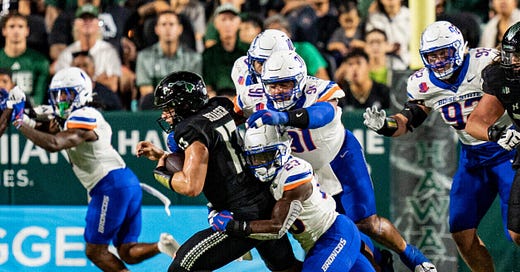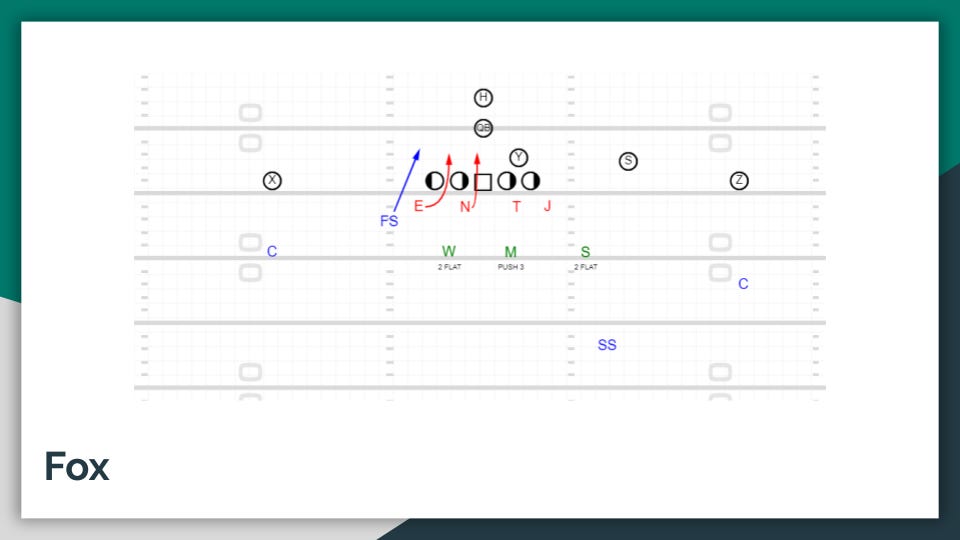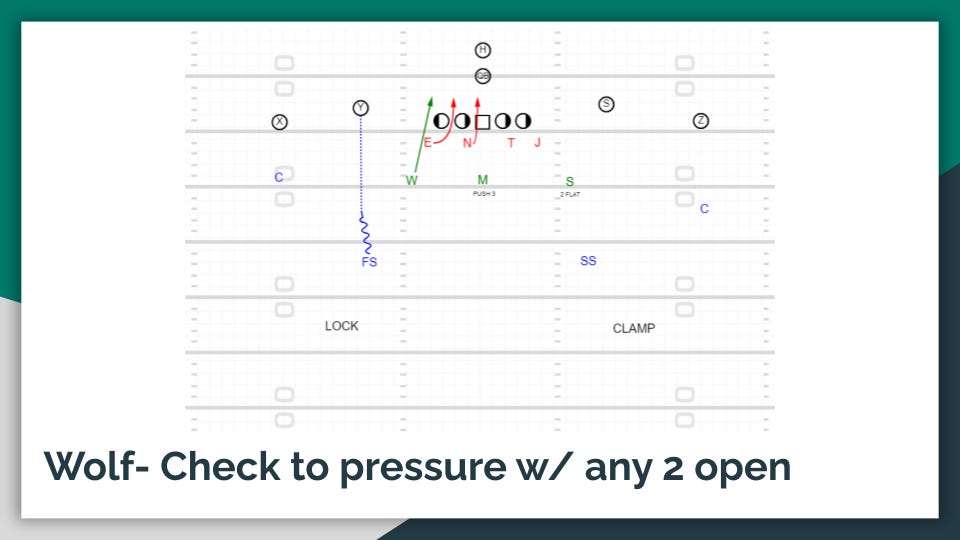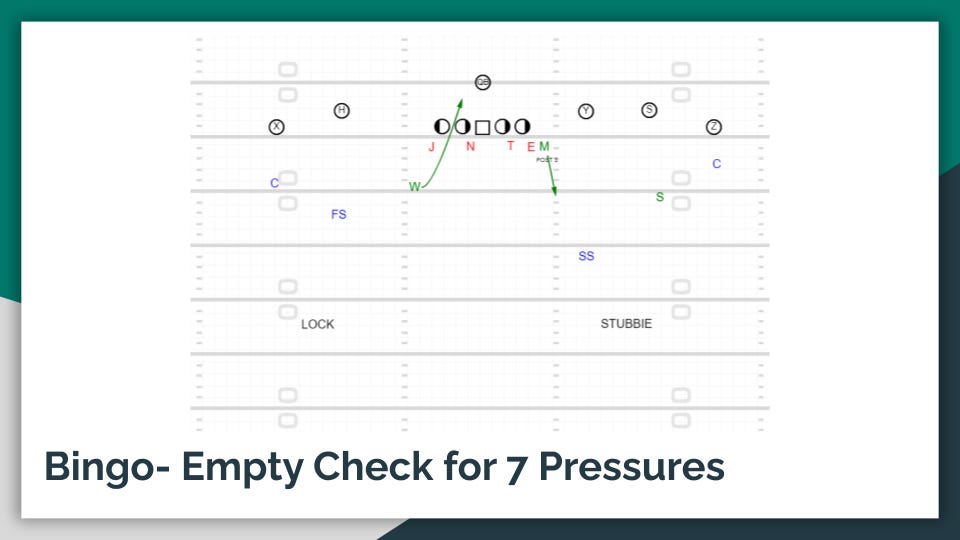Boise State runs a robust pressure package, but one subset in particular sparked a flashback, straight to Nick Saban’s old “Big 12” pressures. For the sake of clarity, we’ll call them Zone Match pressures in this article, but, as always, call them whatever you want. The concept isn’t new, but the way Boise blends these into their blitz packages is worth your time.
These pressures are what I’d label “cheap” for quarters-based teams. They don’t require wholesale changes in back-end structure, and they create real problems for protection schemes. If you’re a coach looking for something you can install on a Sunday and call confidently on a Friday, this family of pressures needs to be on your shortlist.
Base Rules
The rules are simple. To the field, usually the strong side, we play our normal coverage: MOD, Palms, Bracket, whatever’s in the plan that week. To the boundary, we’re bringing a single defender off the edge, or inside, and playing “man” or “match” on the backside. That structure gives us five in the pressure path while staying sound in our zone-match principles.
The best part? Only a couple guys need to change their rules. That means we’re not overhauling the backend every time we dial it up. It’s clean, it’s efficient, and it fits into your existing install. Because the coverage side is made up of day-one concepts, every player already knows the answers, whether the offense gives us 2x2, 3x1, or even a four-strong look. That’s what makes this pressure package so appealing. It’s a call you can get to fast, and it travels.
Boise’s Versions
Boise leans into two variations of this concept, both anchored with quarters principles to the front side. In true Boise fashion, they’re not reinventing the wheel, they’re just rolling it downhill faster than most.
The most common version brings the Will linebacker into the pressure path. That’s their go-to. Boise also sprinkled in some corner pressure from the same structure, giving offenses one more thing to worry about without tipping the backend coverage. It’s the same concept dressed in different clothes, and that disguise forces quarterbacks to confirm everything post-snap.
Bringing the Will
The weak B gap has always been a sweet spot for pressure, and this version is a great reminder why. When Boise brings the Will, they’re attacking the man side of the half-slide. That’s critical. The linebacker comes through untouched. No smoke, no mirrors, just clean, calculated pressure.
In this variation, Boise brings the Will off the edge, which forces the quarterback to throw the flat route on the RPO. Because the ball is coming to the man side, Boise already has a defender coming downhill into the window. The shoot route gets capped immediately, and the defense plays fast without needing to rotate or spin the coverage. It’s a simple way to stress the offense while staying structurally sound on the back end.
There’s one key rule that has to be built into this pressure: if the running back releases to the pressure side, the next linebacker has to take him in man coverage.
It’s a simple adjustment, but it has to be coached with detail. In this clip, the Mike gets caught in the wash, loses the back, and the quarterback dumps it off for a nice gain. These are the kinds of details that turn a great pressure look into a liability if not drilled during the week. It’s not a broken scheme, just a missed assignment.
Bringing the Corner
Bringing the corner is another strong variation in this pressure family, and if you’ve read any of our stuff, you already know we’re big fans of corner pressure.
It’s harder for the offensive line to ID and pick up, plain and simple. Corners aren’t part of the protection count, and they’re athletic enough to beat most backs or tight ends, with speed, tasked with blocking them. On top of that, it’s a great run pressure. The corner gets into the backfield immediately, often before the mesh even happens. That kind of speed forces bad reads and quicker throws, or better yet, a TFL.
Versions Built for a High School Defense
As mentioned earlier, these pressures were Day 1 installs for us. The coverage rules stay intact, and only a few players adjust their assignments, making it perfect for high school implementation.
Below are a few versions we ran ourselves. Each one fits easily into a quarters-based system and can be called against a variety of formations without needing to check out. Simple, fast, and effective, which is the goal.
We kept the calls simple: “Cobra” or “Fox” tagged the pressure, and if the offense aligned in a two-open look, we automatically checked to “Wolf.” No extra communication needed, just built-in rules the kids could play fast with. That’s what made it so effective. The structure stayed consistent, the pressure stayed, and the offense never got a clean pre-snap read.
Like with any pressure, you’ve got to have an answer for empty, and these are no different. When we got an empty look, we checked to “Bingo.” It gave us a clean way to stay in the pressure while matching out routes with leverage and integrity. Again, simple rules that travel week to week, regardless of opponent or formation.
Conclusion
Boise State’s use of Zone Match pressures offers a blueprint for defenses that want to disrupt without sacrificing coverage structure. These pressures are versatile, efficient, and built to live in a quarters world. Whether you’re a college DC or a high school coach looking for fast answers, this family of pressures gives you the ability to be aggressive without blowing the roof off the backend.
They’re easy to install, tough to diagnose, and flexible enough to handle the looks offenses are throwing at you on Friday nights. If you’ve already got a quarters base, these calls plug right in. Just teach the adjustments, drill the checks, and let the pressure handle the rest.









Can you talk about zone match field pressures? Probably match 3, right?